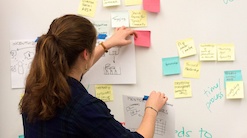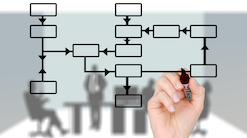Helpful Resources on Business Plans
List of Innovations: Select your product from the List of Innovations, or research and choose another.
Building a Financial Business Plan:
Your financial business plan is an estimate of how your business will balance its revenue with its costs in order to eventually make a profit or break even. If a business does not make a profit or break even immediately, then you may have to take out a loan or find someone to invest in your business for partial ownership.
Use the Prototype to Profit Financial Business Plan Resource to build your financial business plan. You will need to consider one-time expenses, ongoing expenses, revenue, and profits. One-time expenses occur only one time. Ongoing expenses are ones that are needed to build additional versions of the product, to market and sell the product, and to run a business. Usually financial business plans project these by the month.
One-time Expenses:
- Materials: How much will it cost to build your initial product (your prototype) or design your service? This includes the cost of materials and the amount of time it takes to build your prototype or design your service.
- Facilities and Equipment: What kinds of equipment and computers are needed for your business? How much do these cost? How many desks, chairs, and tables will you need?
- Employees: How many people are needed to create, market, and distribute your product? How much do they typically get paid (browse Indeed to learn more about average salaries)?
- Marketing: How do you plan to market and sell your product or service? How much will that cost?
- Other: Is there anything else you need to get started?
Ongoing Expenses:
- Materials: How much will it cost to continue to build or update your product?
- Facilities and Equipment: Where are you planning to locate and run your business? Do you plan to buy or rent those facilities? How much will that cost? How much will is cost to maintain, repair, insure, and replace equipment?
- Employees: How many people are needed to keep producing, marketing, and distributing your product? What are the different roles of these people? How much will it cost to provide your employees with training, benefits, and salary increases?
- Marketing: How do you plan to continue to market and sell your product or service? How much will that cost?
Profit is the difference between a company’s revenue and its total expenses. Revenue includes all money customers pay the business for its product or service. Expenses include all money the business pays to make the product or offer the service.
Predicting Revenue:
- Pricing: How will you price your product or service? Compare your product to other products or services that are similar.
- Predicting: How many “units” of the product or services will you sell in the first year? Second year? Third year?
- Calculate: What is your annual revenue based on these predictions?
Predicting Profit:
- Calculate: What is your company’s monthly profit? If it is a negative number, your business is operating at a loss. If it is positive, you are making more money than you are spending. Most businesses operate at a loss initially.
- Breaking Even: Based on your financial business plan, how long will it be before you make a positive profit?
Math Resources and Tools
Finding the Break Even Point
This resource on Desmos accompanies the Financial Plan spreadsheet from above and helps you learn how to find the break even point for your business. The break even point is the point when your business expenses equal your revenue. Before you can use this tutorial, your teacher will need to assign it to you.




